#vienna 2554
Text



Easter Moralized
This Easter (which, btw, in 2024 is also International Transgender Day of Visibility) we explore the gilded pages of the Vienna Bible Moralisée (moralizing bible), of which we hold the first full-color facsimile published in 1973. The Vienna Bible Moralisée is also known as Vienna 2554, referencing its current place of residence at the Austian National Library in Vienna. One of only three 13th-century moralizing bibles still in existence, this manuscript is an excellent example of the of the ways in which Christians worked to simplify the lessons of the Bible for those that were not theological scholars. Even though they were made to be more accessible, these types of manuscripts were only created for the wealthy class; they needed to understand the Christian Bible and its lessons to ensure that they were (theoretically) promoting moral behavior. Vienna 2554 is thought to have been commissioned by Phillip II Augustus, for his son, Louis VIII or his bride, Blanche of Castile.
The Bible Moralisée is curious for two reasons: it does not actually contain the entire text of the Christian Bible, and it is mostly filled with images, rather than with words. These specific attributes contribute to the accessibility of Christian morals by abbreviating biblical stories and using illuminations to visually represent them.
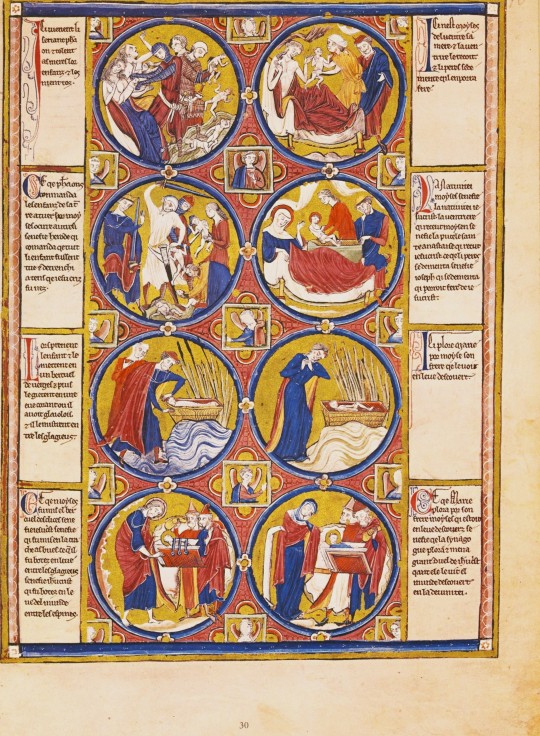
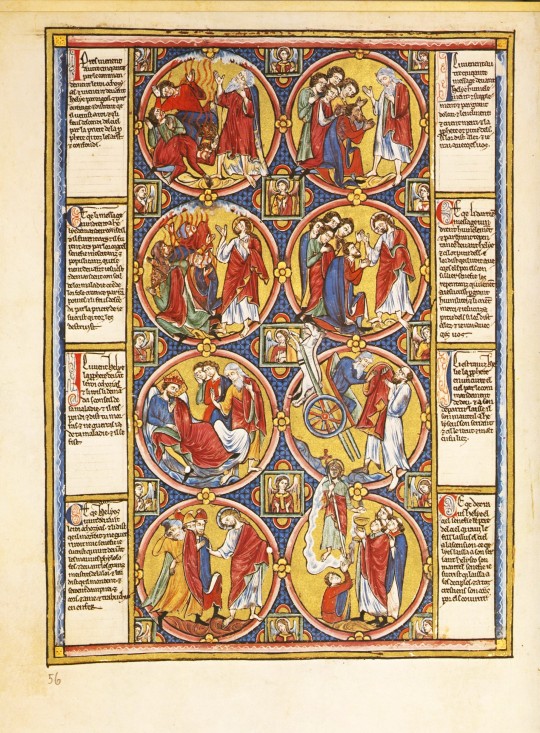
Interestingly, the designs on the pages of these bibles imitate stained glass representations at the time: the eight medallions placed in columns of four; the inclusion of quatrefoils in between these medallions; the use of vivid colors. This reflection of architectural design in the illuminations may have allowed people to visualize themselves in a church and may have led to more contemplative readings of the text that emphasized the teachings of priests and theologians at the time. One of the most well-known images in these types of bibles is Jesus as architect and creator of the universe. This type is seen on the frontispiece of this moralizing bible: Jesus is holding a compass as he focuses on the creation of the world. Geometry and astronomy were often associated with the divine in the Middle Ages and this viewpoint is well explained in Vanderbilt's Divinity Library website: "God has created the universe after geometric and harmonic principles, to seek these principles was therefore to seek and worship God."
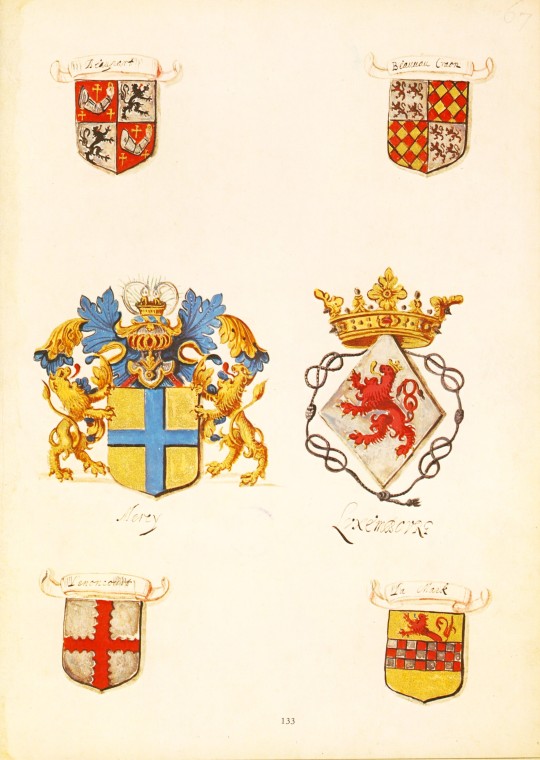
The creation of the moralizing bible also inspired later moralizing versions of books and poetry, like Ovid’s Metamorphoses. These types of moralizing volumes edited and changed parts of the works to make them conform to Christian teachings oft the time.
Our facsimile was published in 1973 by the Akademische Druck- u. Verlagsanstalt in Graz, Austria in an edition of 3,000 copies at the manuscript's original size. To see the original manuscript, you can visit the Österreichische Nationalbibliothek in Vienna or view the entirety of the manuscript online on their website here.
View more manuscript posts.
– Sarah S., Special Collections Graduate Intern
#Easter#bible moralisée#vienna bible moralisée#vienna 2554#austrian national library#Österreichische Nationalbibliothek#moralizing bible#bible#Akademische Druck- u. Verlagsanstalt#Christian bible#facsimiles#manuscripts#illuminated manuscripts#medieval manuscripts#Sarah S.#International Transgender Day of Visibility
51 notes
·
View notes
Text

God as architect of the universe, the frontispiece of Bible moralisée, Paris ca. 1200-1230, Osterreichische Nationalbibliothek, Vienna 2554.
5 notes
·
View notes
Photo

Bible moralisée
1220s
Manuscript (Codex Vindobonensis 2554), 344 x 260 mm
Österreichische Nationalbibliothek, Vienna
“The kind of bible known as Bible moralisée originated at the French royal court during the first thirty years of the 13th century. These bibles used interrelated medallions or rondels (eight per page) as well as marginal texts to interpret bible passages.
While usually written in Latin, the copy in Vienna is in French. It shows on its first page (folio 1v) God the Father bending down to measure the world with a pair of compasses. Holding the cosmic orb in his left hand, he uses his other hand to place one arm of the instrument into the orb's centre in order to draw a circle.”
#Bible moralisée#illuminated manuscripts#illuminated manuscript#medieval#compass#square and compass#Knights Templar#Cistercian#tracing board
16 notes
·
View notes
Text
Bibles moralisées: 13th-century France
Bibles moralisées: 13th-century France
Christ en gloire, frontispice du volume d’Oxford, f.1v. Oxford-Paris-Londres
Our four Bibles are the following:
Codex Vindobonensis 2554 ViennaCodex Vindobonensis 1179 (Vienna)Bible moralisée de saint Louis (Toledo) *Bible moralisée Oxford-Paris-Londres *The Bible of St Louis has an English-language entry.
1. Codex Vindobonensis 2554 (Vienna)Only one of the Bibles moralisées listed above…
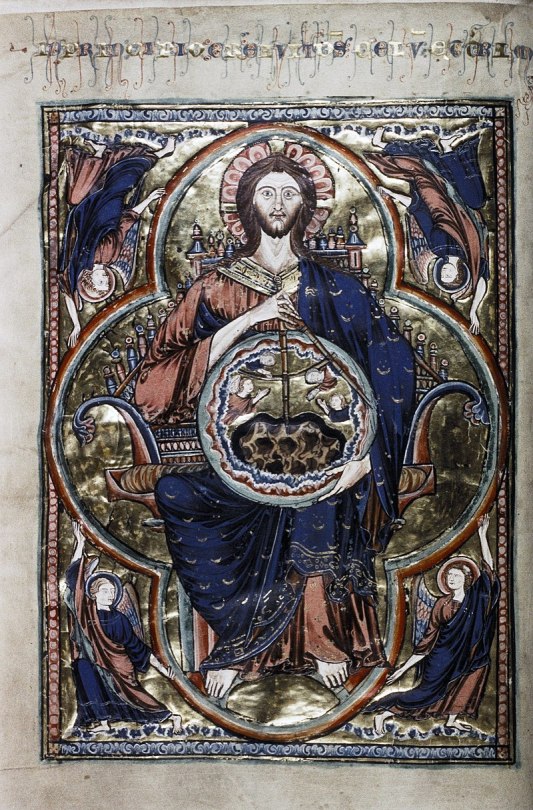
View On WordPress
0 notes
Photo
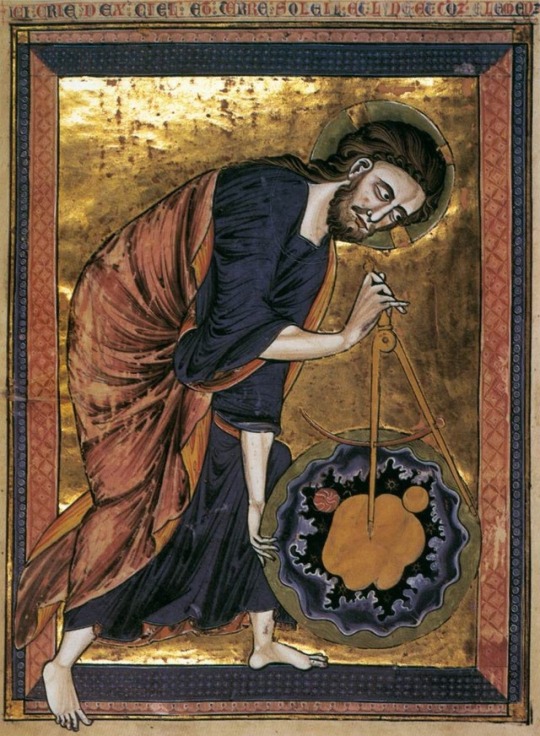







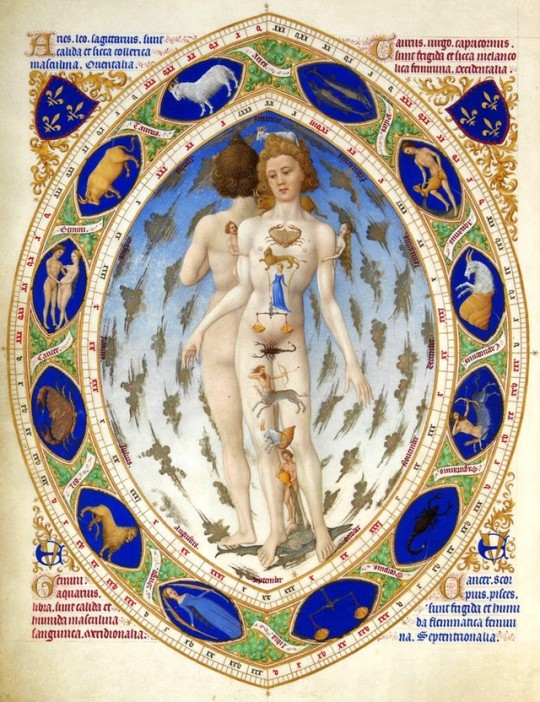

AN INCOMPLETE HISTORY OF MEDIEVAL ART L
MEDIEVAL NATURE IV: COSMOLOGY
The medieval cosmos is not a subset of nature, but an analogous system. If interpreted correctly, both nature and the cosmos allegorize or recapitulate the divine order of things that governs the universe.
The Ptolemaic cosmology of the high Middle Ages is essentially Aristotelian with an overlay of Platonism. The geocentric structure of the universe expounded by Aristotle, consisting of the earth and the seven spheres (the harmonious movements of which create the music of the spheres) managed by the Primum Mobile was painlessly adapted for Christianity, with the seventh sphere as heaven and God as the Prime Mover.
This theory of the cosmos was dominant until the Copernican paradigm shift. It was always recognized as a theory or working explanation of the universe, and not an immutable truth. Ancient and medieval astronomers knew that planet Earth was neither flat, nor close to the stars, nor at the center of the universe. Despite these contradictions, the Ptolemaic model was widely accepted in part because it was intuitive. Viewed from a fixed point on sphere, the sun appears to move across the sky; the heliocentric model can be verified mathematically but not empirically, and therefore requires a leap of faith. At a deeper level, the geocentric model articulated important spiritual ideas concerning order, harmony, and hierarchy. The geocentric worldview is as much philosophy as it is science.
The Bible moralisée is an extended and exhaustive figurative interpretation of the Old and New Testaments. Each of the 4 luxury copies made in the 13th century is prefaced by a full-page miniature depicting God in the act of creating the universe, using the tools of a geometer or architect. The image suggests that an understanding of the divine order that underlies the material universe is analagous to the proper understanding of the higher meaning of sacred scripture.
I use “cosmos” for our forebearers’ idea of the totality of existence because it contains the idea of an ordered whole. It is not that our own universe isn’t in its own way ordered, but in the cosmos the order of things was a humanly meaningful one. That is, the principle of order in the cosmos was closely related to, often identical with, that which gives shape to our lives.
Charles Taylor, A Secular Age
MEDIEVAL NATURE I-IV is the 50th installment in An Incomplete History of Medieval Art. For the series table of contents, click here.
I. Trees and Foliage
II. Animals
III. Excursus - The Unnatural
IV. Cosmology

An Incomplete History of Medieval Art by C. G. Hughes is licensed under a Creative Commons Attribution-NonCommercial-NoDerivatives 4.0 International License.
Permissions beyond the scope of this license may be available at http://lostprofile.tumblr.com/copyright.
#cosmology#medieval science#aristotle#seventh heaven#empyrean#trees#an incomplete history of medieval art#music of the spheres
4 notes
·
View notes
Text
A Forthcoming Post
Christ the Pantocrator in the Bible moralisée Oxford-Paris-Londres
Bible moralisée de saint Louis (Toledo)Bible moralisée Oxford-Paris-LondresCodex Vindobonensis 1179 (Vienna)Codex Vindobonensis 2554 Vienna)
I have been researching our Bibles moralisées. But my work isn’t finished. Blanche de Castile ordered all of these.
There have been interruptions. Hence my being a little late with my…

View On WordPress
0 notes
Text
Chronicling Covid-19 (9): Testing
Prefatory miniature from a moralized Bible of “God as architect of the world”, folio I verso, Paris ca. 1220–1230. Ink, tempera, and gold leaf on vellum 1′ 1½” × 8¼”. Osterreichische Nationalbibliothek, Vienna 2554.
Production
The Spartan cube is exclusive to Canada. I suspect that Spartan Bioscience is unable to manufacture an extremely large number of cubes. The Spartan Cube is a DNA analyzer…
View On WordPress
0 notes